Jai Gupta
SEMQA: Semi-Extractive Multi-Source Question Answering
Nov 08, 2023Abstract:Recently proposed long-form question answering (QA) systems, supported by large language models (LLMs), have shown promising capabilities. Yet, attributing and verifying their generated abstractive answers can be difficult, and automatically evaluating their accuracy remains an ongoing challenge. In this work, we introduce a new QA task for answering multi-answer questions by summarizing multiple diverse sources in a semi-extractive fashion. Specifically, Semi-extractive Multi-source QA (SEMQA) requires models to output a comprehensive answer, while mixing factual quoted spans -- copied verbatim from given input sources -- and non-factual free-text connectors that glue these spans together into a single cohesive passage. This setting bridges the gap between the outputs of well-grounded but constrained extractive QA systems and more fluent but harder to attribute fully abstractive answers. Particularly, it enables a new mode for language models that leverages their advanced language generation capabilities, while also producing fine in-line attributions by-design that are easy to verify, interpret, and evaluate. To study this task, we create the first dataset of this kind, QuoteSum, with human-written semi-extractive answers to natural and generated questions, and define text-based evaluation metrics. Experimenting with several LLMs in various settings, we find this task to be surprisingly challenging, demonstrating the importance of QuoteSum for developing and studying such consolidation capabilities.
How Does Generative Retrieval Scale to Millions of Passages?
May 19, 2023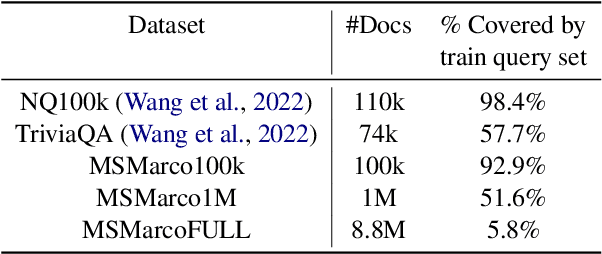
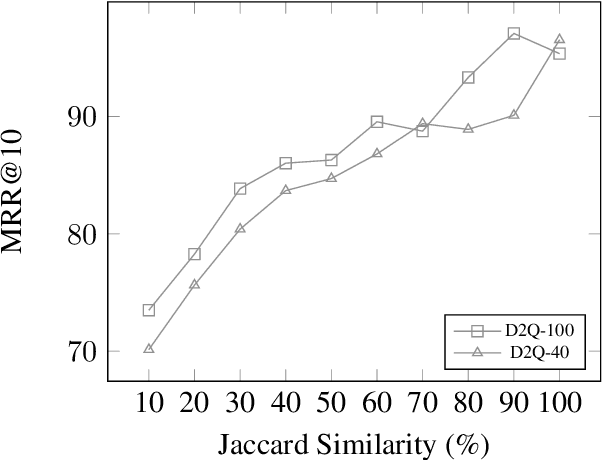
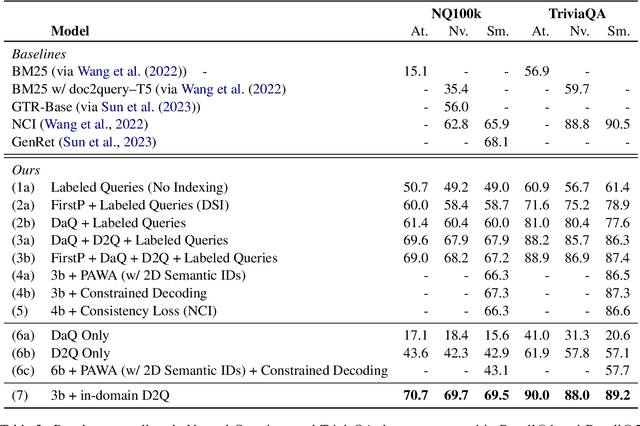
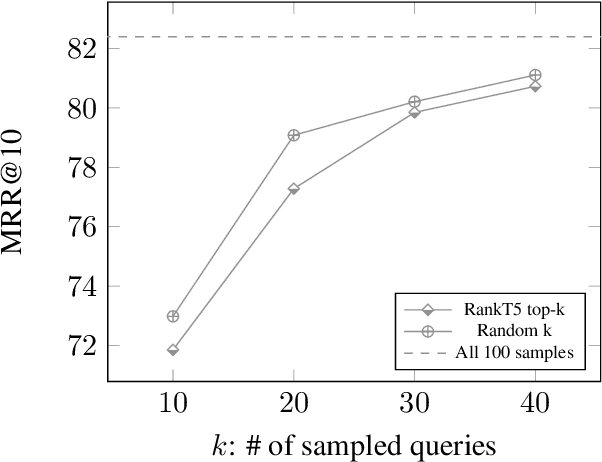
Abstract:Popularized by the Differentiable Search Index, the emerging paradigm of generative retrieval re-frames the classic information retrieval problem into a sequence-to-sequence modeling task, forgoing external indices and encoding an entire document corpus within a single Transformer. Although many different approaches have been proposed to improve the effectiveness of generative retrieval, they have only been evaluated on document corpora on the order of 100k in size. We conduct the first empirical study of generative retrieval techniques across various corpus scales, ultimately scaling up to the entire MS MARCO passage ranking task with a corpus of 8.8M passages and evaluating model sizes up to 11B parameters. We uncover several findings about scaling generative retrieval to millions of passages; notably, the central importance of using synthetic queries as document representations during indexing, the ineffectiveness of existing proposed architecture modifications when accounting for compute cost, and the limits of naively scaling model parameters with respect to retrieval performance. While we find that generative retrieval is competitive with state-of-the-art dual encoders on small corpora, scaling to millions of passages remains an important and unsolved challenge. We believe these findings will be valuable for the community to clarify the current state of generative retrieval, highlight the unique challenges, and inspire new research directions.
DSI++: Updating Transformer Memory with New Documents
Dec 19, 2022Abstract:Differentiable Search Indices (DSIs) encode a corpus of documents in the parameters of a model and use the same model to map queries directly to relevant document identifiers. Despite the strong performance of DSI models, deploying them in situations where the corpus changes over time is computationally expensive because reindexing the corpus requires re-training the model. In this work, we introduce DSI++, a continual learning challenge for DSI to incrementally index new documents while being able to answer queries related to both previously and newly indexed documents. Across different model scales and document identifier representations, we show that continual indexing of new documents leads to considerable forgetting of previously indexed documents. We also hypothesize and verify that the model experiences forgetting events during training, leading to unstable learning. To mitigate these issues, we investigate two approaches. The first focuses on modifying the training dynamics. Flatter minima implicitly alleviate forgetting, so we optimize for flatter loss basins and show that the model stably memorizes more documents (+12\%). Next, we introduce a generative memory to sample pseudo-queries for documents and supplement them during continual indexing to prevent forgetting for the retrieval task. Extensive experiments on novel continual indexing benchmarks based on Natural Questions (NQ) and MS MARCO demonstrate that our proposed solution mitigates forgetting by a significant margin. Concretely, it improves the average Hits@10 by $+21.1\%$ over competitive baselines for NQ and requires $6$ times fewer model updates compared to re-training the DSI model for incrementally indexing five corpora in a sequence.
Dense Feature Memory Augmented Transformers for COVID-19 Vaccination Search Classification
Dec 16, 2022Abstract:With the devastating outbreak of COVID-19, vaccines are one of the crucial lines of defense against mass infection in this global pandemic. Given the protection they provide, vaccines are becoming mandatory in certain social and professional settings. This paper presents a classification model for detecting COVID-19 vaccination related search queries, a machine learning model that is used to generate search insights for COVID-19 vaccinations. The proposed method combines and leverages advancements from modern state-of-the-art (SOTA) natural language understanding (NLU) techniques such as pretrained Transformers with traditional dense features. We propose a novel approach of considering dense features as memory tokens that the model can attend to. We show that this new modeling approach enables a significant improvement to the Vaccine Search Insights (VSI) task, improving a strong well-established gradient-boosting baseline by relative +15% improvement in F1 score and +14% in precision.
Confident Adaptive Language Modeling
Jul 14, 2022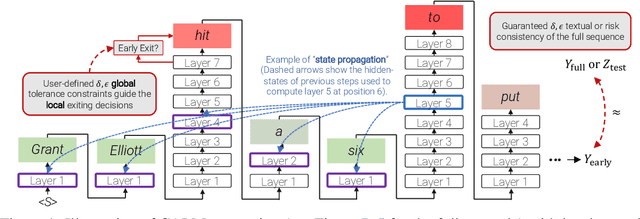
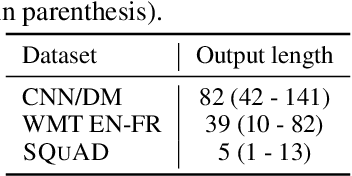

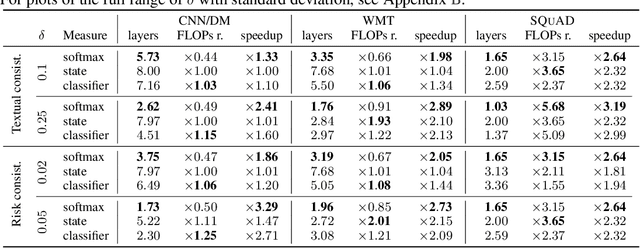
Abstract:Recent advances in Transformer-based large language models (LLMs) have led to significant performance improvements across many tasks. These gains come with a drastic increase in the models' size, potentially leading to slow and costly use at inference time. In practice, however, the series of generations made by LLMs is composed of varying levels of difficulty. While certain predictions truly benefit from the models' full capacity, other continuations are more trivial and can be solved with reduced compute. In this work, we introduce Confident Adaptive Language Modeling (CALM), a framework for dynamically allocating different amounts of compute per input and generation timestep. Early exit decoding involves several challenges that we address here, such as: (1) what confidence measure to use; (2) connecting sequence-level constraints to local per-token exit decisions; and (3) attending back to missing hidden representations due to early exits in previous tokens. Through theoretical analysis and empirical experiments on three diverse text generation tasks, we demonstrate the efficacy of our framework in reducing compute -- potential speedup of up to $\times 3$ -- while provably maintaining high performance.
HyperPrompt: Prompt-based Task-Conditioning of Transformers
Mar 01, 2022



Abstract:Prompt-Tuning is a new paradigm for finetuning pre-trained language models in a parameter-efficient way. Here, we explore the use of HyperNetworks to generate hyper-prompts: we propose HyperPrompt, a novel architecture for prompt-based task-conditioning of self-attention in Transformers. The hyper-prompts are end-to-end learnable via generation by a HyperNetwork. HyperPrompt allows the network to learn task-specific feature maps where the hyper-prompts serve as task global memories for the queries to attend to, at the same time enabling flexible information sharing among tasks. We show that HyperPrompt is competitive against strong multi-task learning baselines with as few as $0.14\%$ of additional task-conditioning parameters, achieving great parameter and computational efficiency. Through extensive empirical experiments, we demonstrate that HyperPrompt can achieve superior performances over strong T5 multi-task learning baselines and parameter-efficient adapter variants including Prompt-Tuning and HyperFormer++ on Natural Language Understanding benchmarks of GLUE and SuperGLUE across many model sizes.
A New Generation of Perspective API: Efficient Multilingual Character-level Transformers
Feb 22, 2022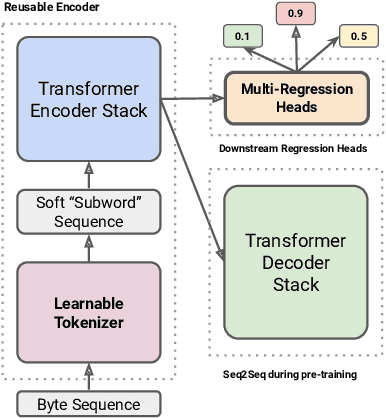
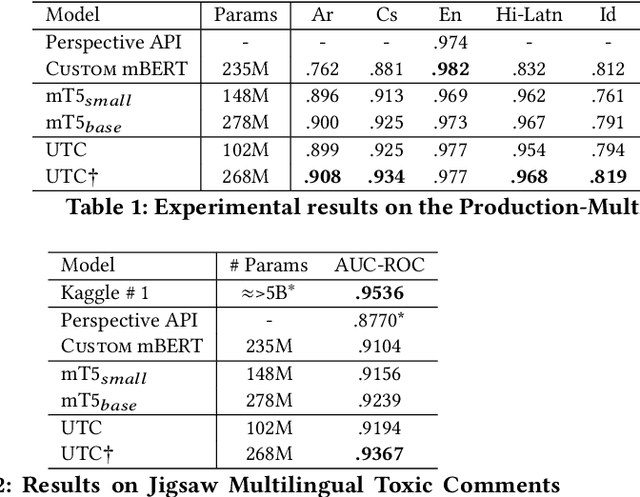
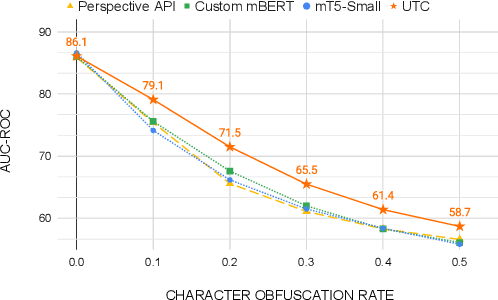
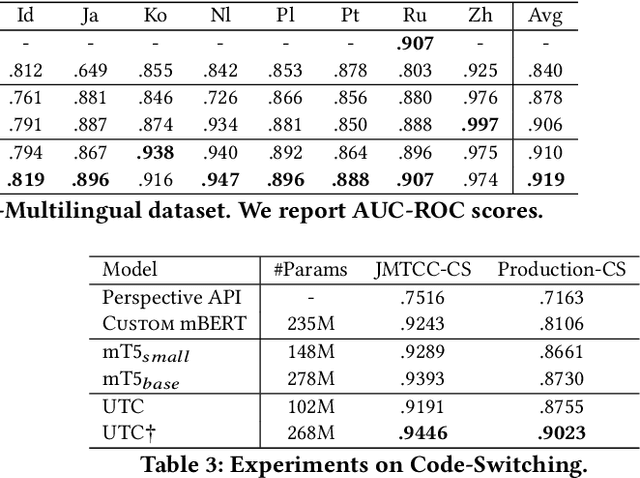
Abstract:On the world wide web, toxic content detectors are a crucial line of defense against potentially hateful and offensive messages. As such, building highly effective classifiers that enable a safer internet is an important research area. Moreover, the web is a highly multilingual, cross-cultural community that develops its own lingo over time. As such, it is crucial to develop models that are effective across a diverse range of languages, usages, and styles. In this paper, we present the fundamentals behind the next version of the Perspective API from Google Jigsaw. At the heart of the approach is a single multilingual token-free Charformer model that is applicable across a range of languages, domains, and tasks. We demonstrate that by forgoing static vocabularies, we gain flexibility across a variety of settings. We additionally outline the techniques employed to make such a byte-level model efficient and feasible for productionization. Through extensive experiments on multilingual toxic comment classification benchmarks derived from real API traffic and evaluation on an array of code-switching, covert toxicity, emoji-based hate, human-readable obfuscation, distribution shift, and bias evaluation settings, we show that our proposed approach outperforms strong baselines. Finally, we present our findings from deploying this system in production.
Transformer Memory as a Differentiable Search Index
Feb 16, 2022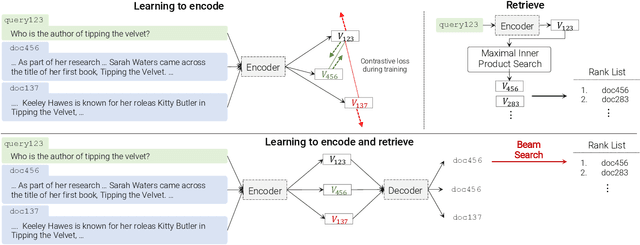

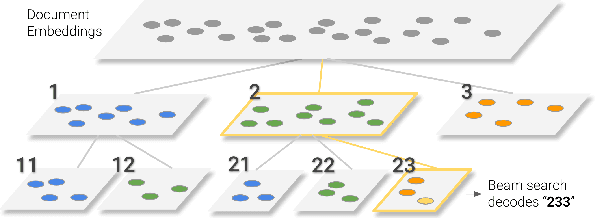

Abstract:In this paper, we demonstrate that information retrieval can be accomplished with a single Transformer, in which all information about the corpus is encoded in the parameters of the model. To this end, we introduce the Differentiable Search Index (DSI), a new paradigm that learns a text-to-text model that maps string queries directly to relevant docids; in other words, a DSI model answers queries directly using only its parameters, dramatically simplifying the whole retrieval process. We study variations in how documents and their identifiers are represented, variations in training procedures, and the interplay between models and corpus sizes. Experiments demonstrate that given appropriate design choices, DSI significantly outperforms strong baselines such as dual encoder models. Moreover, DSI demonstrates strong generalization capabilities, outperforming a BM25 baseline in a zero-shot setup.
ExT5: Towards Extreme Multi-Task Scaling for Transfer Learning
Nov 22, 2021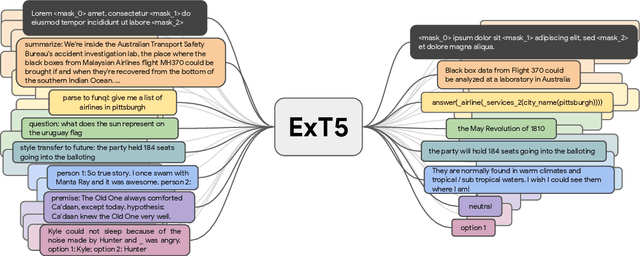
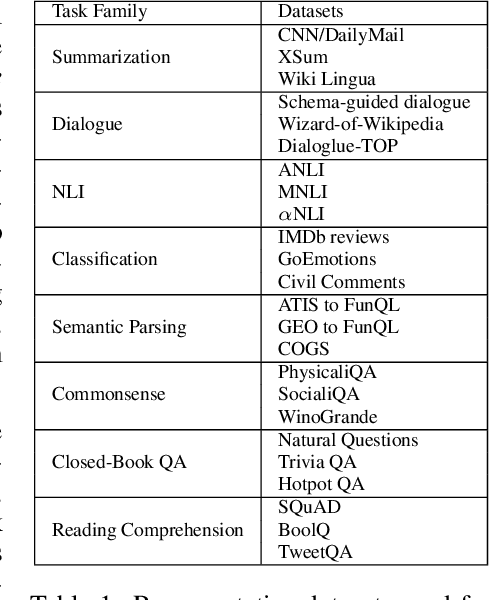
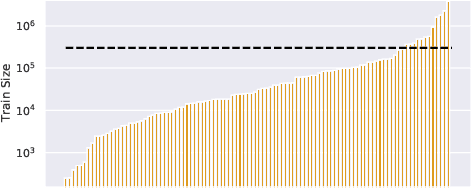
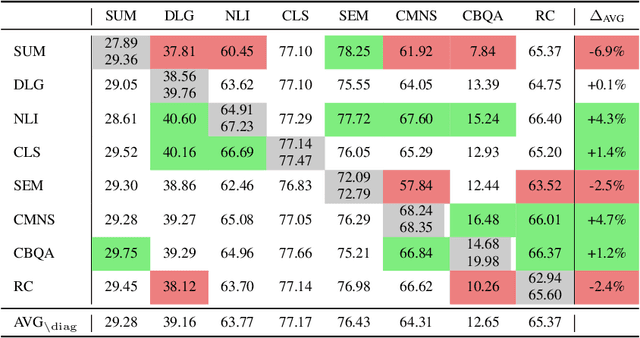
Abstract:Despite the recent success of multi-task learning and transfer learning for natural language processing (NLP), few works have systematically studied the effect of scaling up the number of tasks during pre-training. Towards this goal, this paper introduces ExMix (Extreme Mixture): a massive collection of 107 supervised NLP tasks across diverse domains and task-families. Using ExMix, we study the effect of multi-task pre-training at the largest scale to date, and analyze co-training transfer amongst common families of tasks. Through this analysis, we show that manually curating an ideal set of tasks for multi-task pre-training is not straightforward, and that multi-task scaling can vastly improve models on its own. Finally, we propose ExT5: a model pre-trained using a multi-task objective of self-supervised span denoising and supervised ExMix. Via extensive experiments, we show that ExT5 outperforms strong T5 baselines on SuperGLUE, GEM, Rainbow, Closed-Book QA tasks, and several tasks outside of ExMix. ExT5 also significantly improves sample efficiency while pre-training.
Charformer: Fast Character Transformers via Gradient-based Subword Tokenization
Jul 02, 2021



Abstract:State-of-the-art models in natural language processing rely on separate rigid subword tokenization algorithms, which limit their generalization ability and adaptation to new settings. In this paper, we propose a new model inductive bias that learns a subword tokenization end-to-end as part of the model. To this end, we introduce a soft gradient-based subword tokenization module (GBST) that automatically learns latent subword representations from characters in a data-driven fashion. Concretely, GBST enumerates candidate subword blocks and learns to score them in a position-wise fashion using a block scoring network. We additionally introduce Charformer, a deep Transformer model that integrates GBST and operates on the byte level. Via extensive experiments on English GLUE, multilingual, and noisy text datasets, we show that Charformer outperforms a series of competitive byte-level baselines while generally performing on par and sometimes outperforming subword-based models. Additionally, Charformer is fast, improving the speed of both vanilla byte-level and subword-level Transformers by 28%-100% while maintaining competitive quality. We believe this work paves the way for highly performant token-free models that are trained completely end-to-end.
 Add to Chrome
Add to Chrome Add to Firefox
Add to Firefox Add to Edge
Add to Edge